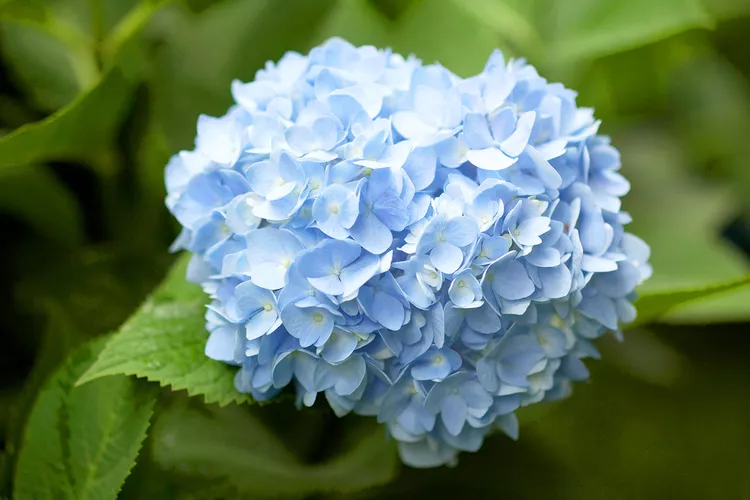Of all the hydrangeas on the market these days, only one species produces the beautiful blue flowers that these plants are known for. Commonly called the bigleaf hydrangea (Hydrangea macrophylla), this type is unique because the flowers (technically sepals) can appear bright pink to purple to bright blue, depending on the soil acidity. You can enjoy these stunning blue blooms on scores of cultivars in either mophead or lacecap style. The best blue hydrangeas in this list also offer improved characteristics such as reblooming, compact size, and more hardiness.
Bigleaf Hydrangea Growing Tips
Native to East Asia, bigleaf hydrangeas are hardy in Zones 5-9 (some varieties are even more hardy). They prefer organically enriched moist soils with good drainage and a partly sunny location, although they can handle full sun in cool summer regions provided they’re given ample moisture. In colder regions, you may need to provide some winter protection to ensure your hydrangeas bloom the following year.
Nikko Blue
If you’ve seen large blue hydrangea flowers before, chances are you’ve seen this cultivar. Coming from Japan, 'Nikko Blue' reliably turns blue in home gardens and like the bigleaf species, grows to about 6 feet tall and wide. Plant your 'Nikko Blue' in moist, well-mulched soils in part shade for them to look their best throughout the growing season.
Endless Summer
Endless Summer is often credited for changing the game for hydrangeas with their ability to produce flower buds on old and new growth, unlike the species which produces flower buds only on the previous year’s growth. This ability and hardiness down to Zone 4 has allowed northern gardeners to enjoy the “mophead” blooms of bigleaf hydrangeas without fear of losing buds over winter. Endless Summer grows slightly shorter than the species.
Pop Star
A newer introduction in the Endless Summer line, Pop Star features electric blue lacecap flower heads all summer long on very sturdy stems. These plants are fairly compact, growing to just 3 feet tall and wide at maturity. Pop Star also is very hardy, reliably coming back each spring down to Zone 4.
Blue Enchantress
Another reblooming blue hydrangea with hardiness to boot, 'Blue Enchantress' grows to a max height and width of about 5 feet, making it a bit more compact than the species. Blooms start out a light sky blue and eventually change to a creamy green.
Blue Jangles
From the Let’s Dance series, 'Blue Jangles' is an improvement on color in the reblooming and dwarf categories. Growing to only 3 feet tall and exceptionally compact, this small hydrangea is great for tight spaces and containers.
Starlight
Another addition from the Let’s Dance series, 'Starlight' produces gorgeous lacecap flowers. Unlike the traditional mophead look, lacecaps produce flattened flower heads that bloom more sporadically, producing a starry look. It gets up to 4 feet tall and is best grown in Zones 5-9.
Big Daddy
Heading in a totally different direction in terms of size and flower shape, 'Big Daddy' is a large hydrangea, reaching upwards of 6 feet tall and produces huge mophead type flowers. A little more sensitive than most on the list, this gentle giant prefers part shade and constant moisture to maintain its giant flower heads and is only hardy to Zone 6 and higher.
Cape Cod
Back on the smaller end of the spectrum, 'Cape Cod' is a part of the Seaside Serenade series that combines a small size (about 4 feet tall and wide) and hardiness down to Zone 4. This blue hydrangea is great for in-ground plantings in the north and grow them in pots year-round further south. 'Cape Cod' is a repeat bloomer with two tone blue and white individual flowers, giving it a unique look.
Twist-N-Shout
'Twist-N-Shout' combines cold hardiness with a maximum size of 4 feet tall and wide, lacecap style, and repeat blooms. Against the darker, unopened buds, the light blue color of the flower heads really pops, creating a beautiful and eye-catching effect.
Keeping Blue Hydrangeas Blue
In basic to neutral soils, bigleaf hydrangeas will produce pink flowers while in acidic soils, blue flowers are produced. So if your soil has a neutral or higher pH, you will need to treat the soil around your blue hydrangeas with aluminum sulfate to keep that blue color.
While there are many home remedies for acidifying the soil such as mulching with pine needles and coffee grounds or citrus peels, the best and most effective way is to purchase ready-made soil acidifier products at your local garden center. These products will not only do the trick, but have longer-lasting effects. They contain both an acidifier as well as aluminum, which is also necessary for producing blue hydrangeas. Plus, some of these acidifiers include additional plant nutrients as well to support the overall health of your plant. Plan to add the acidifier in spring before buds begin to break open, and again in late fall.




















